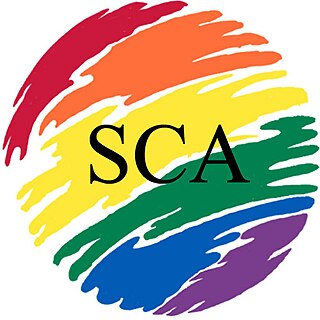
Alcoholics Anonymous (AA) is a global peer-led mutual aid fellowship begun in the United States dedicated to abstinence-based recovery from alcoholism through its spiritually inclined twelve-step program. AA's twelve traditions, besides stressing anonymity, establish it as non-professional, unafiliated, non-denominational and apolitical with a public relations policy of attraction rather than promotion. In 2020 AA estimated a worldwide membership of over two million, with 75% of those in the US and Canada.
Twelve-step programs are international mutual aid programs supporting recovery from substance addictions, behavioral addictions and compulsions. Developed in the 1930s, the first twelve-step program, Alcoholics Anonymous (AA), founded by Bill Wilson and Bob Smith, aided its membership to overcome alcoholism. Since that time dozens of other organizations have been derived from AA's approach to address problems as varied as drug addiction, compulsive gambling, sex, and overeating. All twelve-step programs utilize a version of AA's suggested twelve steps first published in the 1939 book Alcoholics Anonymous: The Story of How More Than One Hundred Men Have Recovered from Alcoholism.

Bulimia nervosa, also known as simply bulimia, is an eating disorder characterized by binge eating followed by purging or fasting, and excessive concern with body shape and weight. This activity aims to expel the body of calories eaten from the binging phase of the process. Binge eating refers to eating a large amount of food in a short amount of time. Purging refers to the attempts to get rid of the food consumed. This may be done by vomiting or taking laxatives.
Overeating occurs when an individual consumes more calories in relation to the energy that is expended via physical activity or expelled via excretion, leading to weight gain and often obesity. Overeating is the defining characteristic of binge eating disorder.
Disordered eating describes a variety of abnormal eating behaviors that, by themselves, do not warrant diagnosis of an eating disorder.
A food addiction or eating addiction is any behavioral addiction that is primarily characterized by the compulsive consumption of palatable food items which markedly activate the reward system in humans and other animals despite adverse consequences.

Starved is an American television sitcom that aired for one season on FX for seven episodes in 2005. The series was about four friends who each suffer from eating disorders, who met at a "shame-based" support group called Belt Tighteners. Its characters included those with bulimia, anorexia, and binge eating disorder. Eric Schaeffer created the show as well as writing, starring in and directing it, based upon his own struggle with eating disorders. In addition to his own life experiences, Schaeffer also drew upon the experiences of the other members of the principal cast, each of whom coincidentally had struggled with food issues of their own.
Pagans in recovery is a phrase, which is frequently used within the recovery community, to describe the collective efforts of Neopagans as well as Indigenous, Hindu, Buddhist, and other like-minded groups, to achieve abstinence or the remission of compulsive/addictive behaviors through twelve-step programs and other programs, such as Alcoholics Anonymous, Narcotics Anonymous, Overeaters Anonymous, Al-Anon/Alateen, etc. These efforts generally focus on modifying or adapting the twelve steps to accommodate the Pagan world-view as well as creating Pagan-friendly twelve step meetings either as part of a preexisting twelve-step program or as independent entities.

Emotions Anonymous (EA) is a twelve-step program for recovery from mental and emotional illness. As of 2017 there were approximately 300 Emotions Anonymous groups active in the United States and another 300 around the world.

Compulsive behavior is defined as performing an action persistently and repetitively. Compulsive behaviors could be an attempt to make obsessions go away. Compulsive behaviors are a need to reduce apprehension caused by internal feelings a person wants to abstain from or control. A major cause of compulsive behavior is said to be obsessive–compulsive disorder (OCD). "The main idea of compulsive behavior is that the likely excessive activity is not connected to the purpose to which it appears directed." There are many different types of compulsive behaviors including shopping, hoarding, eating, gambling, trichotillomania and picking skin, itching, checking, counting, washing, sex, and more. Also, there are cultural examples of compulsive behavior.

Sexual Compulsives Anonymous (SCA) is a twelve-step program for people who want to stop having compulsive sex. SCA founding is attributed variously to 1982 in New York City and to 1973 in Los Angeles. Although the fellowship originally sought to address issues of sexual compulsion among gay and bisexual men, and this is still the fellowships predominant demographic, today the program is LGBT friendly, open to all sexual orientations, and there is an increasing number of women and heterosexual men participating. SCA meetings are most likely to be held in urban areas with larger gay and bisexual male populations. The majority of members are white, but vary in age and socioeconomic background. The only requirement for membership is a desire to stop having compulsive sex.
Gamblers Anonymous (GA) is an international fellowship of people who have a compulsive gambling problem. They meet regularly to share their "experiences, strength and hope", so they can help each other solve the problems compulsive gambling has created in their lives, and to help others recover from the addiction of compulsive gambling. The only requirement for membership is a desire to stop gambling, as stated in the GA Combo book page 2.
Debtors Anonymous (DA) is a twelve-step program for people who want to stop incurring unsecured debt. Collectively they attend more than 500 weekly meetings in fifteen countries, according to data released in 2011. Those who compulsively incur unsecured debt are said to be engaged in compulsive borrowing and are known as compulsive debtors.
Sex and Love Addicts Anonymous (SLAA) is a twelve-step program for people recovering from sex addiction and love addiction. SLAA was founded in Boston, Massachusetts in 1976, by a member of Alcoholics Anonymous (AA). Though he had been a member of AA for many years, he repeatedly acted out and was serially unfaithful to his wife. He founded SLAA as an attempt to stop his compulsive sexual and "romantic" behavior. SLAA is also sometimes known as the Augustine Fellowship, because early members saw many of their shared symptoms described by St. Augustine of Hippo in his work Confessions. COSLAA is another twelve-step fellowship created to support the family members and friends of sex and love addicts.
Drug addiction recovery groups are voluntary associations of people who share a common desire to overcome their drug addiction. Different groups use different methods, ranging from completely secular to explicitly spiritual. Some programs may advocate a reduction in the use of drugs rather than outright abstention. One survey of members found active involvement in any addiction recovery group correlates with higher chances of maintaining sobriety. Although there is not a difference in whether group or individual therapy is better for the patient, studies show that any therapy increases positive outcomes for patients with substance use disorder. The survey found group participation increased when the individual members' beliefs matched those of their primary support group. Analysis of the survey results found a significant positive correlation between the religiosity of members and their participation in twelve-step programs and to a lesser level in non-religious SMART Recovery groups, the correlation factor being three times smaller for SMART Recovery than for twelve-step addiction recovery groups. Religiosity was inversely related to participation in Secular Organizations for Sobriety.
Workaholics Anonymous (WA) is a twelve-step program founded circa 1983 for people identifying themselves as "powerless over compulsive work, worry, or activity" including, but not limited to, workaholics–including overworkers and those who suffer from unmanageable procrastination or work aversion. Anybody with a desire to stop working compulsively is welcome at a WA meeting. Unmanageability can include compulsive work in housework, hobbies, fitness, or volunteering as well as in paid work. Anyone with a problematic relationship with work is welcomed. Workaholics Anonymous is considered an effective program for those who need its help.
Survivors of Incest Anonymous (SIA) is a twelve-step fellowship for recovery from the consequences of childhood sexual abuse. SIA was founded in 1982 in Baltimore, Maryland by women who believed their experience in other twelve-step fellowships could assist in recovery from sexual trauma. In SIA incest is defined broadly as any sexual behavior imposed on one person by a member of his or her immediate or extended family. The extended family, in this definition, includes but is not limited to: grandparents, uncles, aunts, in-laws, clergy, teachers, cousins, family friends, and stepparents. The abuse may include verbal abuse, emotional abuse and physical behaviors; penetration is not necessary for meeting SIA's definition on incest. Covert incest within the family is also a theme many survivors explore in SIA.
Food Addicts in Recovery Anonymous (FA) founded in 1998 is a program of recovery based on the twelve steps of Alcoholics Anonymous. FA members are men and women of all ages. Some have been obese; others have been severely underweight, bulimic, or so obsessed with food or weight that normal life was difficult or impossible. The common denominator uniting members of FA is addiction and a relationship with food that parallels an alcoholic's relationship with alcohol. The program offers the hope of long-term recovery, evidenced by members who have continuously maintained a normal weight and healthy eating for periods of twenty-five or even thirty years.






